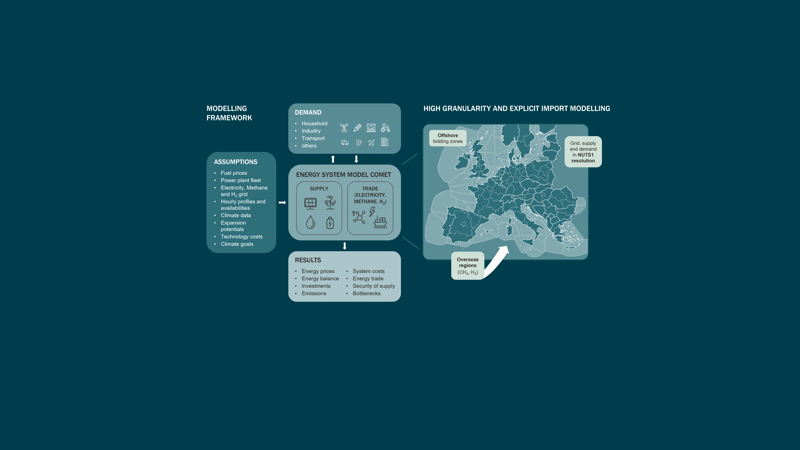
COMET delivers integrated, high-resolution insights across technologies, sectors, and geographies – empowering informed decisions for an affordable, resilient, and fully decarbonised energy system.
The energy transition is one of the major challenges of our time – demanding coordinated action across sectors, geographies, and the entire value chain. As the system grows more complex, with diverse energy carriers and interdependent technologies, advanced energy market models are essential.
COMET – our Cross-sector Optimisation Model for the Energy Transition – provides policymakers, system planners, and investors with critical insights into the design of tomorrow’s decarbonised energy system. Covering electricity, gases (methane and hydrogen), liquids, biofuels, and emerging energy carriers (like synthetic fuels and Ammonia), COMET assesses infrastructure, technologies, and supply pathways required to create an affordable, efficient, and resilient energy system through 2050 and beyond.
Model highlights and key features
- Integrated sector coupling: Comprehensive analysis across all sectors, technologies, and fuels.
- Long-term development: Cost-optimal investment and dispatch until 2050.
- Security of supply: Robust analysis during periods of low renewable generation and peak demand (Dunkelflaute)
- International cooperation: Insight into European and global market dynamics.
- High geographic resolution: Detailed analysis for up to 100+ regions.
- High temporal granularity: Hourly energy balance for representative weeks. 8,760-hour electricity dispatch modelling.
- Detailed representation of electricity markets: Unit-based modelling for EU electricity markets.
- Detailed representation of final demand: Over 30 final demand sectors.
- Demand-side flexibility: Modelling active participation of prosumers and industrial processes in energy markets.
- Final demand optimisation: Endogenous investment decisions in final demand sectors.
- Infrastructure optimisation: Endogenous investment in electricity, methane and hydrogen grids.
Want to know how COMET can work for you? Contact our expert Stefan Lorenczik at stefan.lorenczik@frontier-economics.com
Applications
COMET provides a powerful combination of standardised results, tailored solutions, and complementary qualitative economic insights, supported by expert knowledge across all sectors and energy carriers.
Market rules critically shape incentives and guide the energy transition along an affordable, sustainable, and secure trajectory. COMET clarifies the complexity and uncertainty surrounding regulatory changes.
Examples:
- Implications of introducing/removing technology support schemes (e.g. renewables like wind and solar) – for individual market participants/technologies, and for the overall system. Expected costs and welfare implications.
- Market impacts of phasing out technologies (e.g. coal or nuclear plants) on market prices, utilities’ revenues, and profits.
- Effects of electricity bidding zone splits on electricity prices, consumer costs, and overall welfare.
COMET’s objective and transparent analyses support dispute resolution by clearly assessing market dynamics, impacts of policy measures, and technology interactions. Unlike commercial tools, Frontier has full access to the inner workings of COMET, ensuring we are always able to explain what is driving a particular result.
Examples:
- Quantifying financial impacts of regulatory decisions or market interventions on stakeholders.
- Evaluating claims related to grid congestion, system balancing, or security of supply.
- Providing independent assessment of compliance with regulatory frameworks and contractual obligations.
COMET supports investment decisions by clarifying economic viability, risks, and strategic opportunities within the evolving energy landscape.
Examples:
- Identifying optimal investment portfolios under uncertain policy and market conditions.
- Evaluating revenue potentials and risks for new infrastructure or technology investments.
- Assessing the robustness of investment plans under different scenarios.
COMET helps stakeholders prioritise infrastructure development by assessing system-wide impacts, integration needs, and long-term value.
Examples:
- Analysing cost-benefit scenarios for grid expansions or upgrades.
- Evaluating electricity, hydrogen, and methane infrastructure requirements and integration opportunities.
- Assessing resilience of existing infrastructure against future market conditions.
Download our COMET brochure ⬇️
Get examples of COMET in use and see how it can work for you!
Click here to downloadCase study: How COMET models the optimal path to net zero
We used this model as part of a study for Eurogas, assessing the role of gas in Europe’s transition to net zero.
Read the full case study


